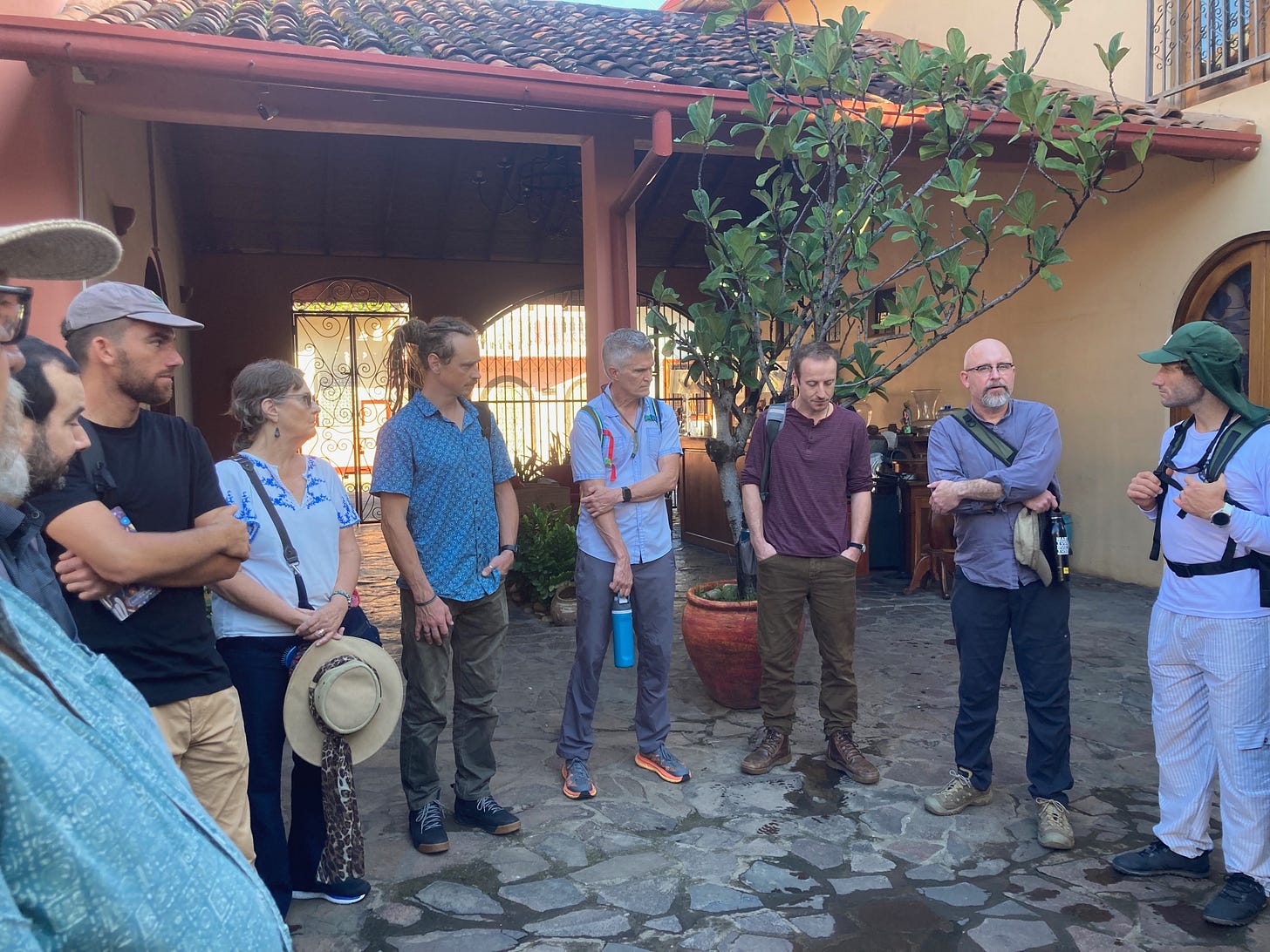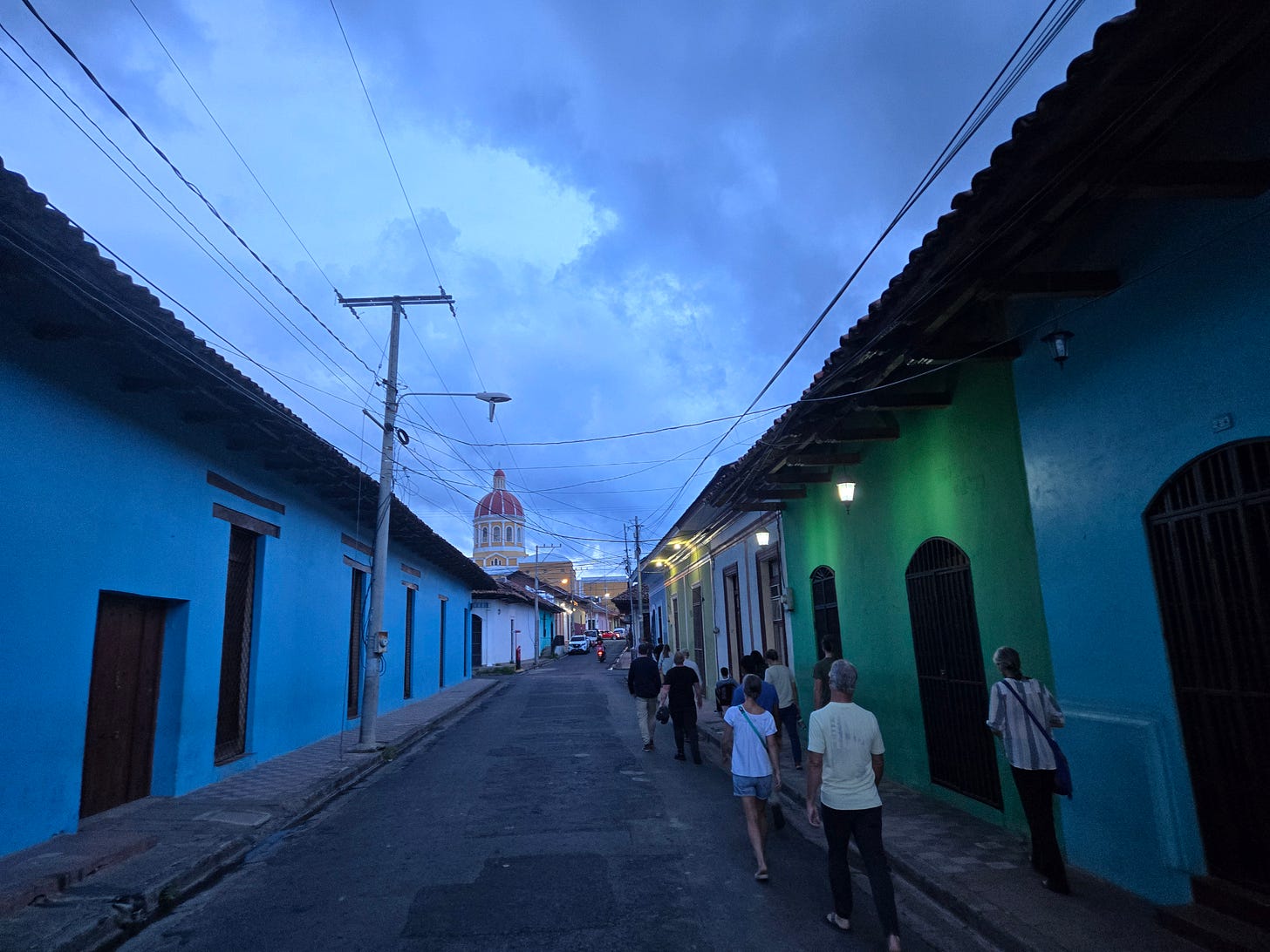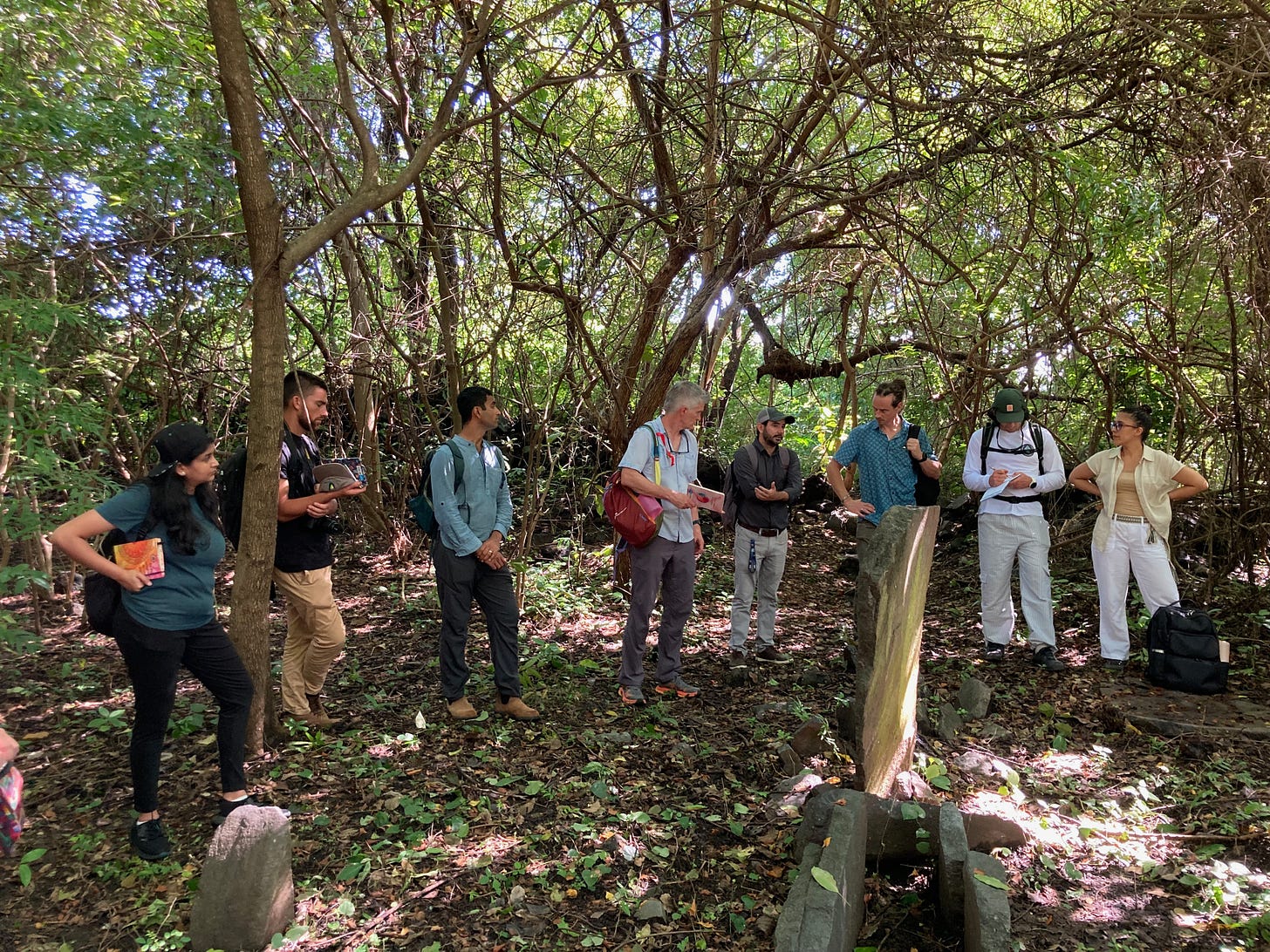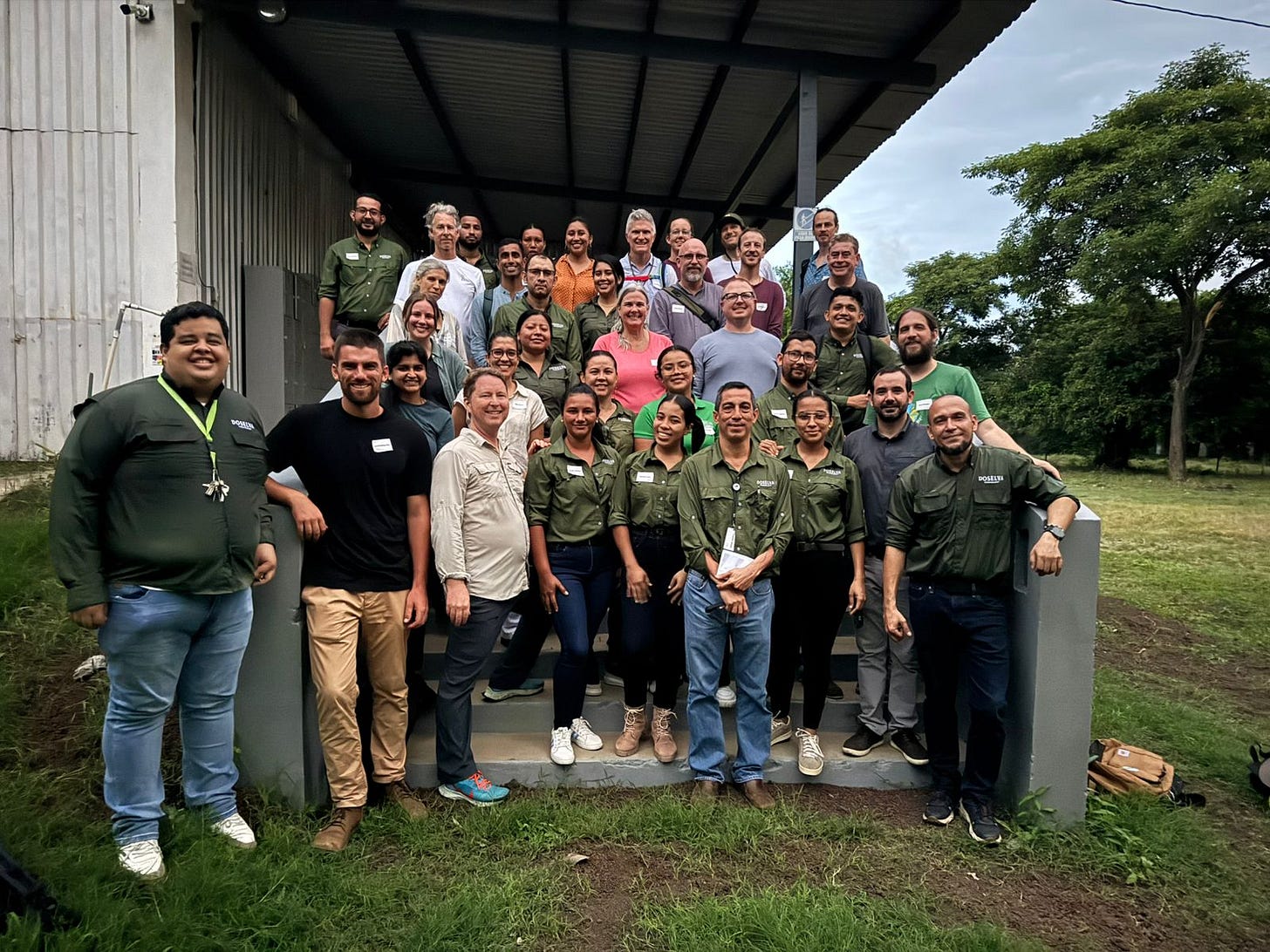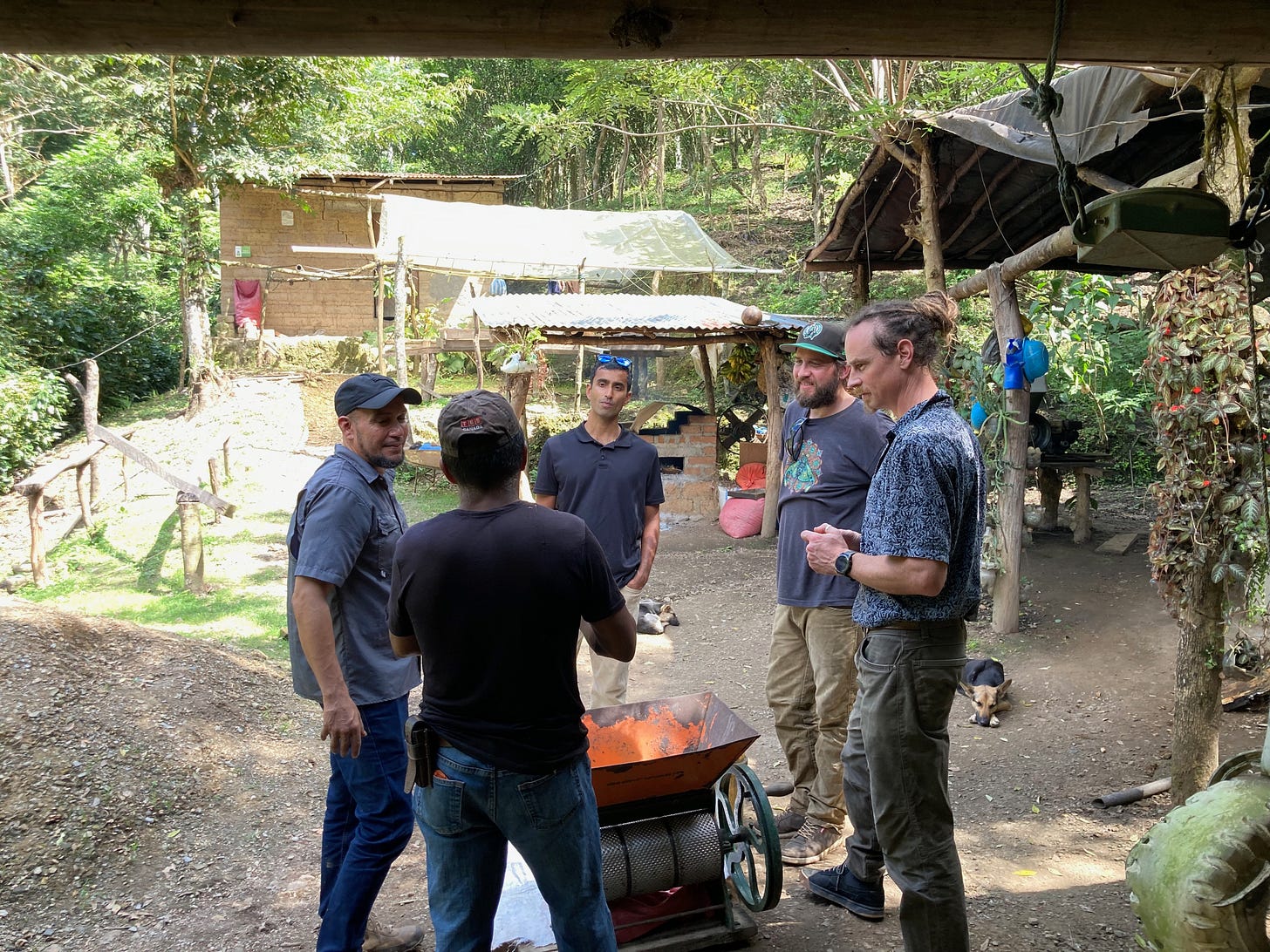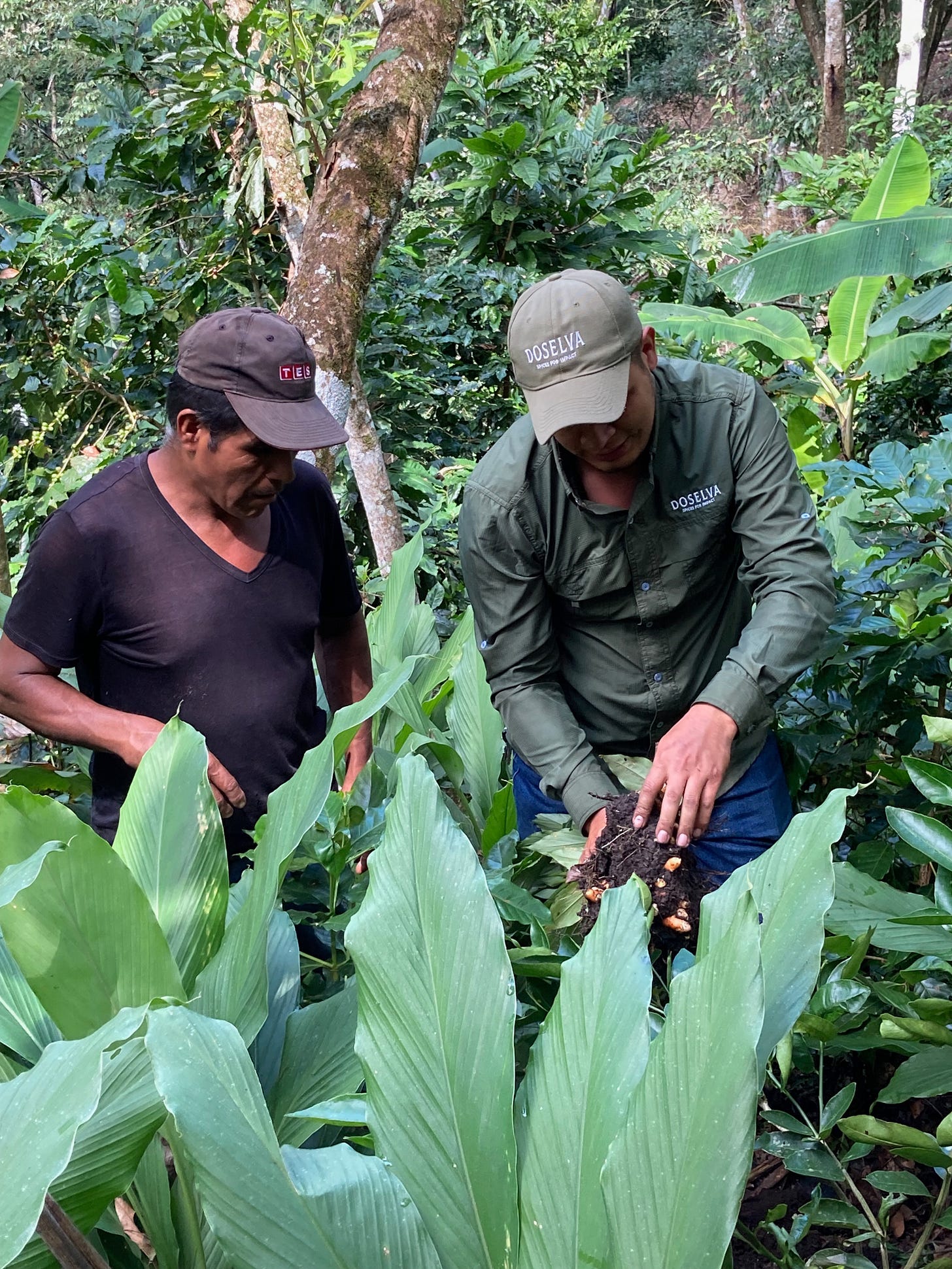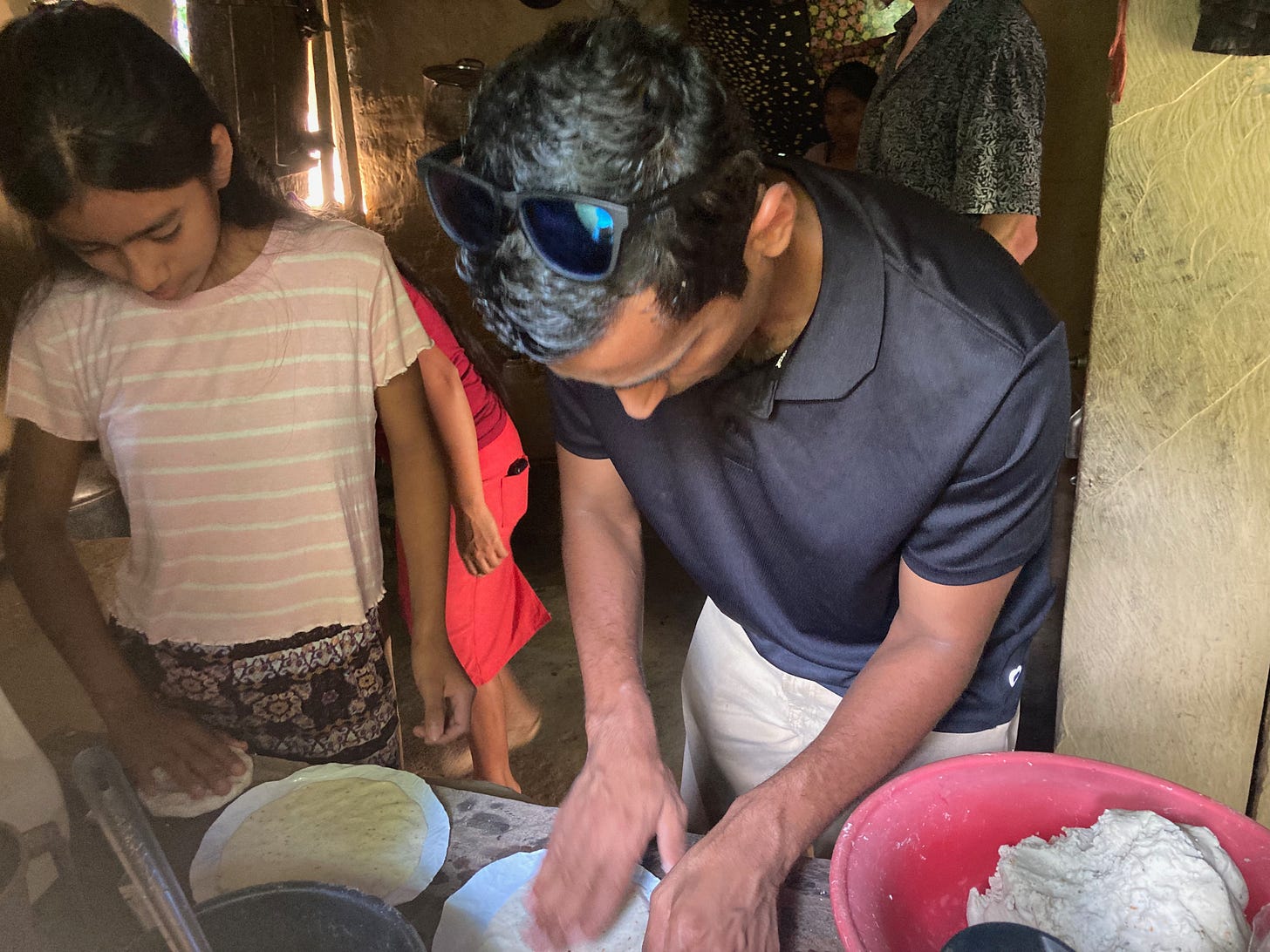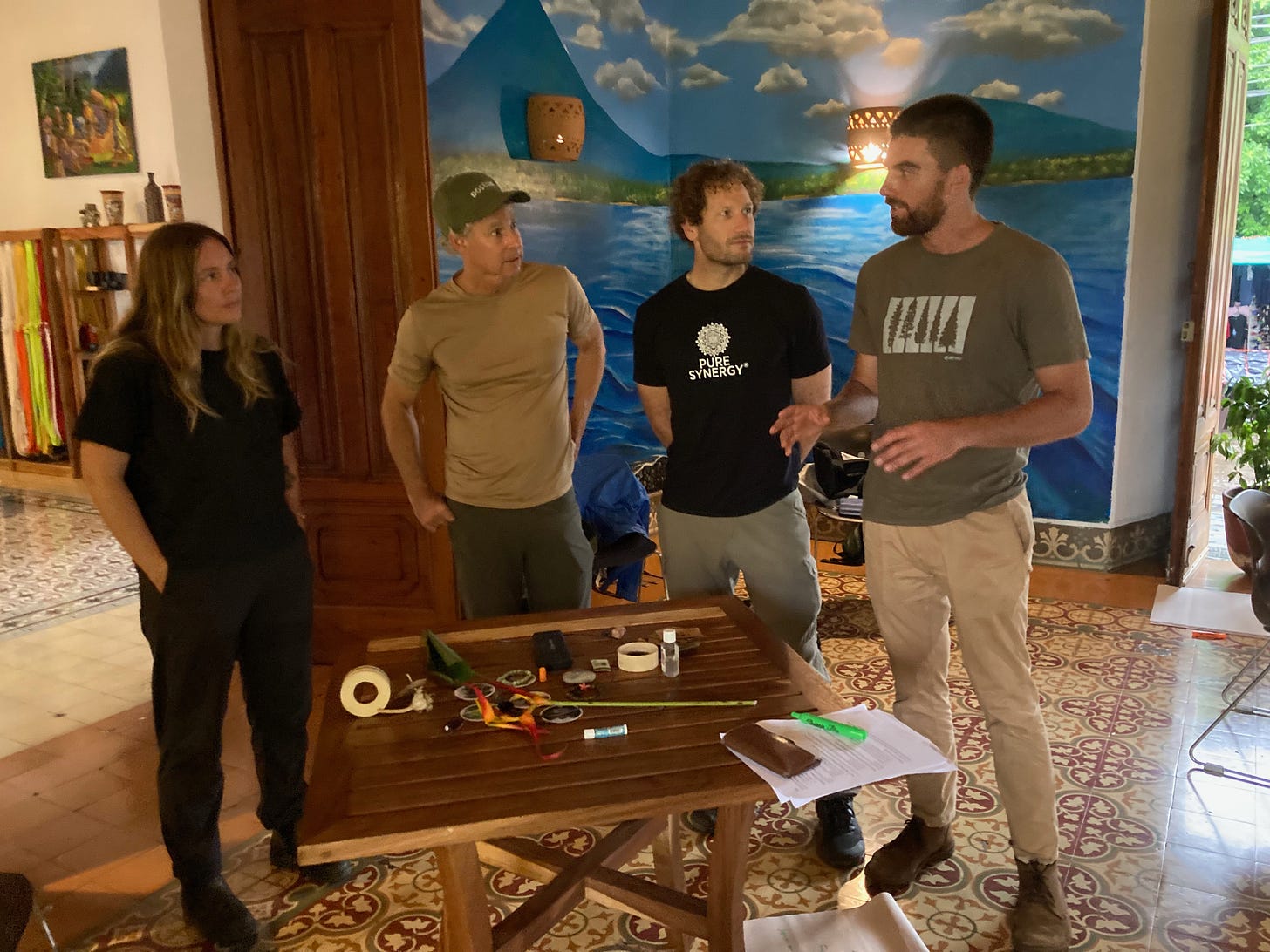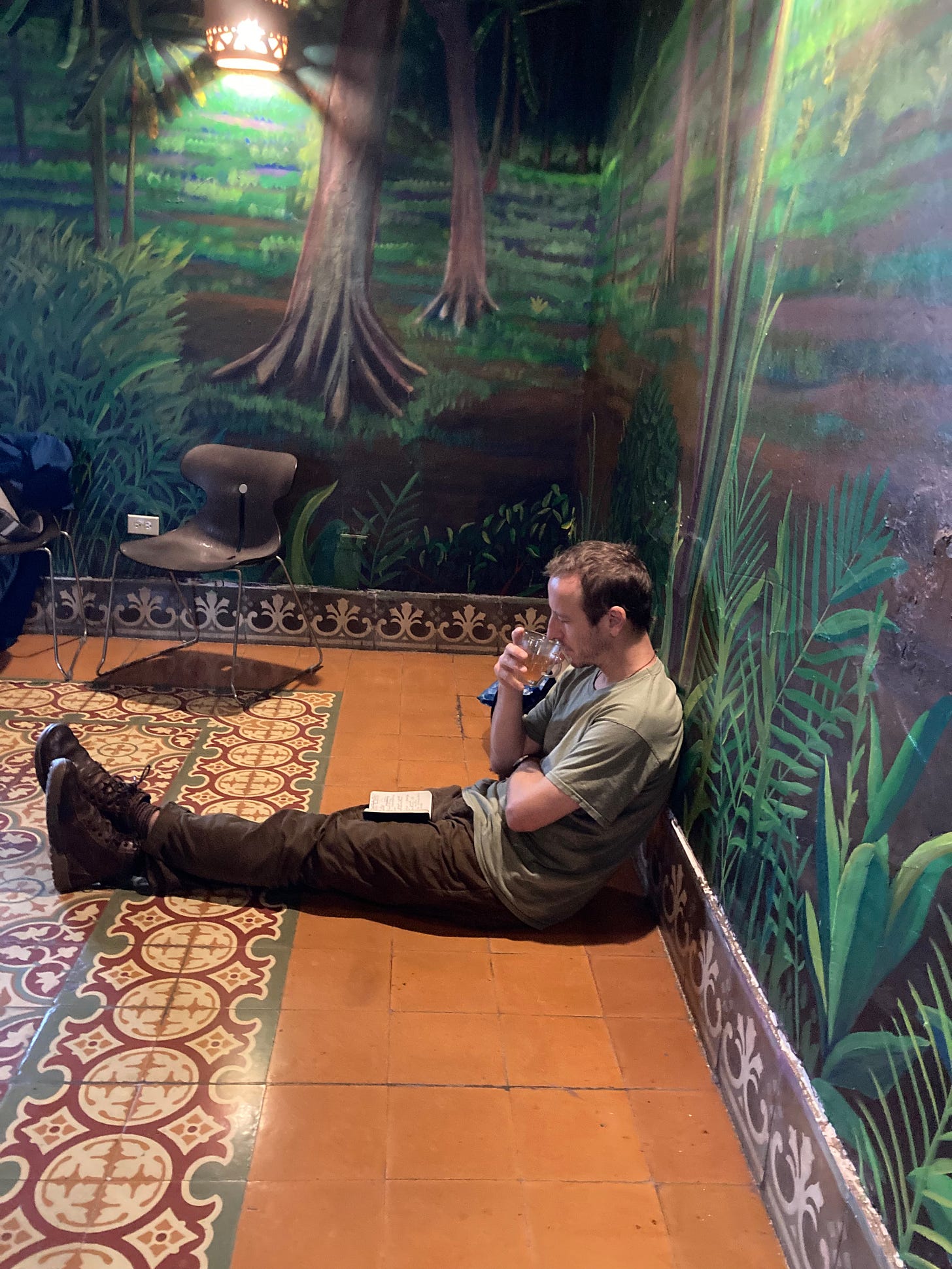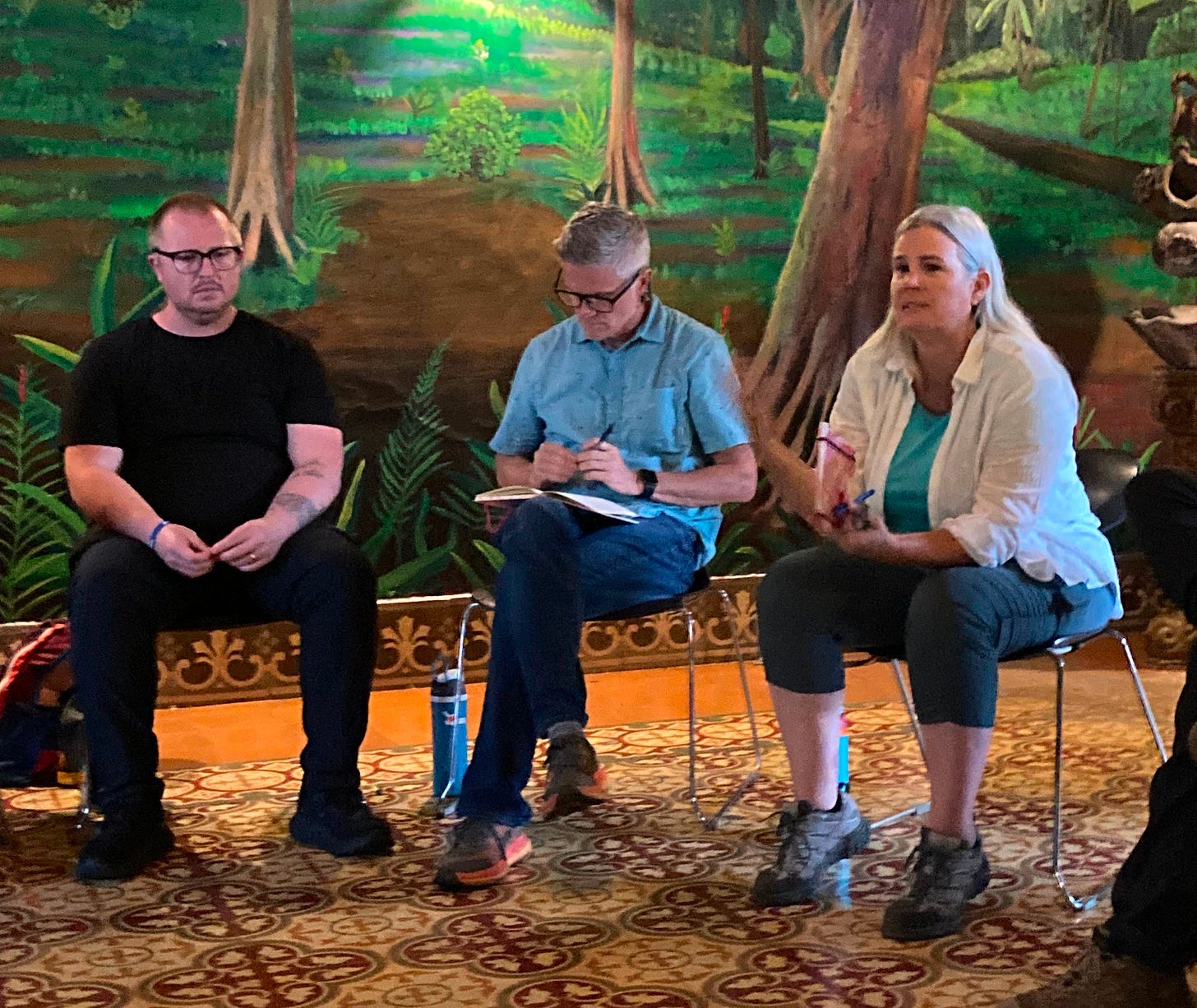Arriving in Nicaragua: The SHI Learning Journeys
Seventeen Sustainable Herbs Initiative members gathered in Granada, Nicaragua for the third SHI Learning Journey. The group included individuals from leading mission driven herb companies (Gaia, Traditional Medicinals, Pure Synergy, Pacific Botanicals, Banyan Botanicals, Yogi Tea, Organic Herb Trading Company, Eurofins, ES Botanicals, Young Mountain Tea, Herbs Artisan, and a forestry professor from Virginia Tech). Many of us had been meeting monthly or more for almost the past four years to explore ways to address some of the seemingly intractable challenges in the herb industry. This was our first time visiting a source community in the Global South, a region faced by challenging social, economic, and environmental issues. For me one of the most powerful parts of these learning journeys was not only they they offer a change to have meaningful conversations about issues I cared deeply about, it was a chance to do it with people I also cared deeply about.
Jefferson Shriver, founder and CEO of Doselva and our host for the week, had been part of the group from the beginning. Over two and a half years ago, while driving to northern Nicaragua to visit Doselva farmers, he and I had dreamed about organizing herb learning journeys in Nicaragua and elsewhere. Jefferson had joined each of the Learning Journeys so far, the first in Appalachia, the second in Oregon. It was exciting to be making that dream real.
Setting the Context
We stayed in a hotel on a quiet street off the main square in Granada. The first evening we gathered in a circle to briefly frame the week. It was the week after the US election, which for many of us heightened our sense of the urgency of the times. I began by sharing what Bill McKibben had written about how the head winds are now stronger, and that the veil has been lifted. I commented on the realness and hardness in the world right now which mirrors the realness and hardness of Nicaragua.
Jefferson then spoke about how this Learning Journey built on the previous two, both on the relationships that we have been developing among each other and also in going more deeply into the challenges and issues that the herb industry is facing especially in sourcing from smallholder farming communities facing high levels of outmigration.
He outlined the plan for our week and then provided a bit of cultural and historical context for Nicaragua. In particular he talked about how volcanos had shaped this landscape, which made me think of the fiery nature of the plants we were here to spend time with: ginger and turmeric.
Dialogue walks and community building
We then walked silently down the busy central street to the lake side, over mosaics in the pavement of quetzals and parakeets and other birds I didn’t know, I only noticed the brilliance of the colors and the care of creating beauty in a road.
At the lake, we each greeted the land in our own way, finding a way perhaps to somehow acknowledge that many of us came from a country with a tortured history in this place and with these people. I stood by the lake and asked for the ability to listen. To open myself to what was here for me to hear.
We then walked back from the lake to the Gaia Forest Café, a café on the edge of the main square also owned and managed by Jefferson. We each paired with someone we didn't know well, asking them to share three experiences that shaped who they are now. I walked with Jefferson, whom I've spoken to often in different contexts. Yet I never knew that as a child he lived in the Philippines while his father was a missionary, or what it was like to return to suburban California in middle school. I thought how little we really know of each other's stories and the value of having a structure that allowed us to share in this deeper way.
When we arrived at the Café, we gathered in a circle again in a room painted in a stunning rich green forested mural, it felt like we were standing in a forest. We each shared our intention for the week.
Julia Weaver later commented on how these conversations helped build community – and that if we are going to solve these challenges, having a strong community is key. She added that it helped her begin the week by becoming attuned to the value of listening.
Uncovering Historical Layers: Archaeological Insights
Visit to pre-Columbian archaeological sites
During the Oregon Learning Journey this past June, we met with Brook Colley, Associate Professor of Native American Studies, Southern Oregon University. She said to begin a journey by asking three fundamental questions: Who lived here? What happened? Where are they now? And What did they know?
And so, early the next morning Jefferson had arranged for us to visit a pre-Columbian archaeologist site with the two archaeologists Geoffery and Sharisse McCaffery who had been working there.
We again gathered in a circle before heading to the boat. I read, “Bone” by Mary Oliver, which ends:
“and what the soul is, also
I believe I will never quite know.
Though I play at the edges of knowing,
truly I know
our part is not knowing,
but looking, and touching, and loving,
which is the way I walked on,
softly,/through the pale-pink morning light.”
Reflections on land, heritage, and colonization
We took an hour long boat ride to Chorotega Island of the Dead and then followed Geoffrey and Sharisse into the jungle. This site was uncovered in the early 2000s when the excavation of a new road revealed human remains, mostly teeth, and fragments of pottery. When Geoffrey and Sharisse first asked permission from the land owner, he refused. Yet, after time of building trust, the Salablanca family agreed to a collaborative exploration of the land.
For more details on the site, see Finn Rautenbach’s description of our visit.
Later we gathered at the Salabanca home where these historical sites were found. Don Mariana shared how he wants to preserve this land because he thinks when you die, you need to let people rest. He wants to keep this site as a resting place.
Some shared their reflections. Nate Brennan drew a striking parallel between the antiquities trade and the botanical trade—both exploiting regions where communities are compelled to sell their heritage for mere survival. Finn Rautenbach mentioned the difference of living in a place for thousands of years without the need to leave a sign. There are no pyramids at this site, much, perhaps, to the archaeologist’s disappointment, but perhaps with a deeper message for us all.
Guido Masé commented that this made him wonder, as a brand, what is the right depth to tell the story to those who buy their products? How can we respectfully tell the stories and histories of the places from which herbs are sourced? Ones that honor the importance of history in shaping the present, not just as a way to sell a product?
Inside Processing: A Holistic View of Production
Visit to Doselva's Processing Center
From there, we went to the Primary Processing Center where we gathered at picnic tables with staff for a lunch celebrating the 4th year anniversary of the processing center (the processing center now has 45 permanent staff and 50-75 during the high season).
Before beginning to eat, everyone, from Jefferson to the workers slicing ginger, introduced themselves, a simple gesture that took more time, but like so many of the simple gestures through the week opened pathways of connection.
Jefferson spoke about the crisis in coffee lands, a crisis of sustainability and of livelihood. If farmers lose the ability to grow coffee, what will they do? Converting to cattle is one of the main options which is one of the biggest causes of deforestation in the country. Doselva is working to diversify coffee farming lands to include other species, turmeric, ginger, cardamon so that farmers have different sources of income at different times of the year.
I’ve been on plenty of tours of processing centers. After the first one or two, they all fade together. Jefferson and his team instead structured our visit around stations where we could do some work. We trimmed ginger rhizomes with sharp knives, work that took concentration and focus and that quickly made me aware of the slow passage of time. And the next job, which I enjoyed much more because we could move and there were no sharp knives: carrying ginger into the greenhouse to spread on long screens for a first round of drying before going into driers.
After our tour, our small group joined the others in our group outside at the picnic tables.
Understanding the human side of herb processing
As the light faded, we again sat in a circle and shared our reflections from the day:
Awe at the depth of knowledge and experience of the people we interacted with.
Inspired by how this visit brought honor to a stage that is often invisible in sourcing herbs.
Being humbled by and grateful for the amount of work and the passion, wondering how to share that with those who purchase their products.
What does resilience mean in a company in terms of what each person brings to the system? How does individual resilience contribute to company resilience?
Impressed with Doselva’s agility, and with what Jefferson has been able to accomplish.
Struck by the value of good leadership and trust. The employees care about the product because Jefferson cares about them.
Struck by the confidence and competence of the team: People know their work and are comfortable talking about it. Wondering what part of that is Nicaragua, what part is Deselva’s selection of people, and what part is the leadership that brings out that confidence and competence.
Farmer Connections: Stories from the Land
The next morning, we set off early for a hike on Mombacho volcano, before splitting into small groups for the 6-7 hour drive to San Juan Rio de Coco, where we'd meet farmers in Doselva's network the following day.
For the first leg of the drive, each person was invited to share two or three experiences that brought them to the work that they are now doing. Conversations deepened, moving from casual chatter to intimate stories about who we are and what drives us, creating a powerful sense of connection within the group. We stopped in the pouring rain to get gas, salty snacks, and to change groups. This time the question was around a personal or professional threshold we each are now facing in our lives. Some groups spent the entire three hours sharing their reflections.

We arrived in San Juan Rio de Coco in the dark. The restaurant where we planned to eat was closed and so Jefferson and Olga Duarte found another café where the staff were willing to go to the grocery store to buy the food needed to feed 20 unexpected guests after hours on a Tuesday night.
Farmlands that are Full of Life
San Juan Rio del Coco is the coffee region of Nicaragua. One hundred and fifty thousand sacks (one sack is 45 kilos or 100 lbs) of coffee leave this region annually, Osmar Centeno, the technical advisor of Doselva, explained the next morning. Ten thousand farmers in the region are organized into coops that handle the exports, marketing, training, etc. Eighty five percent are growing organically certified coffee with FairTrade schemes. This essentially makes this region a certified organic landscape, he said.
The coffee is traditionally planted in a shade grown setting, the shade is forest shade, not planted trees. Doselva’s goal is to enhance the diversity that is already in this region.
I was in a small group that visited Freddy Lobo who was in his first year of growing turmeric to sell to Doselva. With the help of four people he hired, Freddy planted 28,000 plants of turmeric rhizomes on his 7-hectare farm where he primarily grows coffee and cacao. He also grows limes, bananas, citrus, and a few other products that he had spread out on a table to show us when we arrived. His wife was cooking on an open air mud stove while his young daughter, dressed in a bright red jumper and wearing a red headband with reindeer antlers, hung back shyly.
Freddy Lobo got this land in 1995. Nothing was here. The land had been abandoned during the civil war. All the trees had been cleared, he said. “There had been so much shooting, no one wanted to live here.” He told us he wanted us to know this history. “This is what I do,” he said, gesturing to show the produce spread out on the table. “Everything you see here, I have made it.” Juan Carlos Rivera, an agronomist for Doselva who was translating, added, “The land used to be full of death. And now it is full of life.”
Everything on this table is money, Freddy said. And the coffee is gold. The coffee harvest is the happy time because it means they’ll have money. Juan Carlos explained to Freddy that now, by growing turmeric, the hope is that Freddy will have more happy times in the year.
I asked Freddy what he hoped for his daughter. He turned to her and said, “What do you want in your future, my love?”
Reciprocity and mutual understanding
We helped harvest coffee, which none of us were very good at. It seemed fairly simple close to the house but became much more difficult a bit further as the bank became so steep it was hard to stand without holding onto branches.
As we left, Freddy said, “I feel proud and motivated to see you come here. Even for you to be here is an honor.” And, he added, that it was the first time anyone had come there and brought gifts.
As we walked down the steep trail, jumping on rocks across the stream, I thought about the difference between gift giving and buying. The first time anyone brought gifts. Which was the way our whole interaction felt. Unlike previous supplier visits which typically focused on compliance and a discussion about farm practices—this time, it felt like an exchange. It was subtle, but crucial: this was about mutual respect, not just the usual business transaction.
Intention Matters
On the drive over, Guido, Nate, Raj Vable and I had been talking about what questions we could ask that didn’t feel extractive. As he navigated the deep ruts in the dirt road with the truck, Juan Carlos said that just having that intention made the difference. I had been skeptical, thought there was a right way to do this that mattered. But as we reflected on the visit, I realized he was right. The combination of our intention, how we showed up, and the planning done by Doselva, made this visit unlike any supplier visit I’d been on.
As we drove to the next farmer, Juan Carlos said that if he had come on his own and suggested that Freddy plant more, he likely would have said no, it’s too much work. But this time, after seeing and hearing our interest and understanding where the turmeric would go (we gave them products produced by the companies visiting: turmeric tea, golden milk, and turmeric capsules) Freddy had told him, “I’m your guy to plant more.”
Our group then went to a second farm, where last spring, Estansia, one of women farmers in Doselva’s network, had planted turmeric rhizomes on their coffee farm. The family had made a banner on the mud wall to celebrate our arrival. They also had set up a display of produce from their farm.
This time we went inside the small dark kitchen to help cook. Sweating from the heat of the fire, we ground maize that had been soaking, kneaded flour, and then rolled and cooked the tortillas on the mud stove. We chopped tomatoes and onions for egg drop soup. Only after eating did we climb the hill out back to help hill the turmeric plants and to see their fields.
Bringing the Magic Back In
In the reflection circle later, Nate mentioned Estansia’s surprise to see the size of the turmeric root Osmar dug to see how it was doing. Nate said, “Growing herbs takes immense effort, yet we often take the process for granted. There's magic in the faith these farmers place in the land—believing that what they sow will grow, even as they navigate unknowns. How can we bring that magic back to those who take it for granted?”
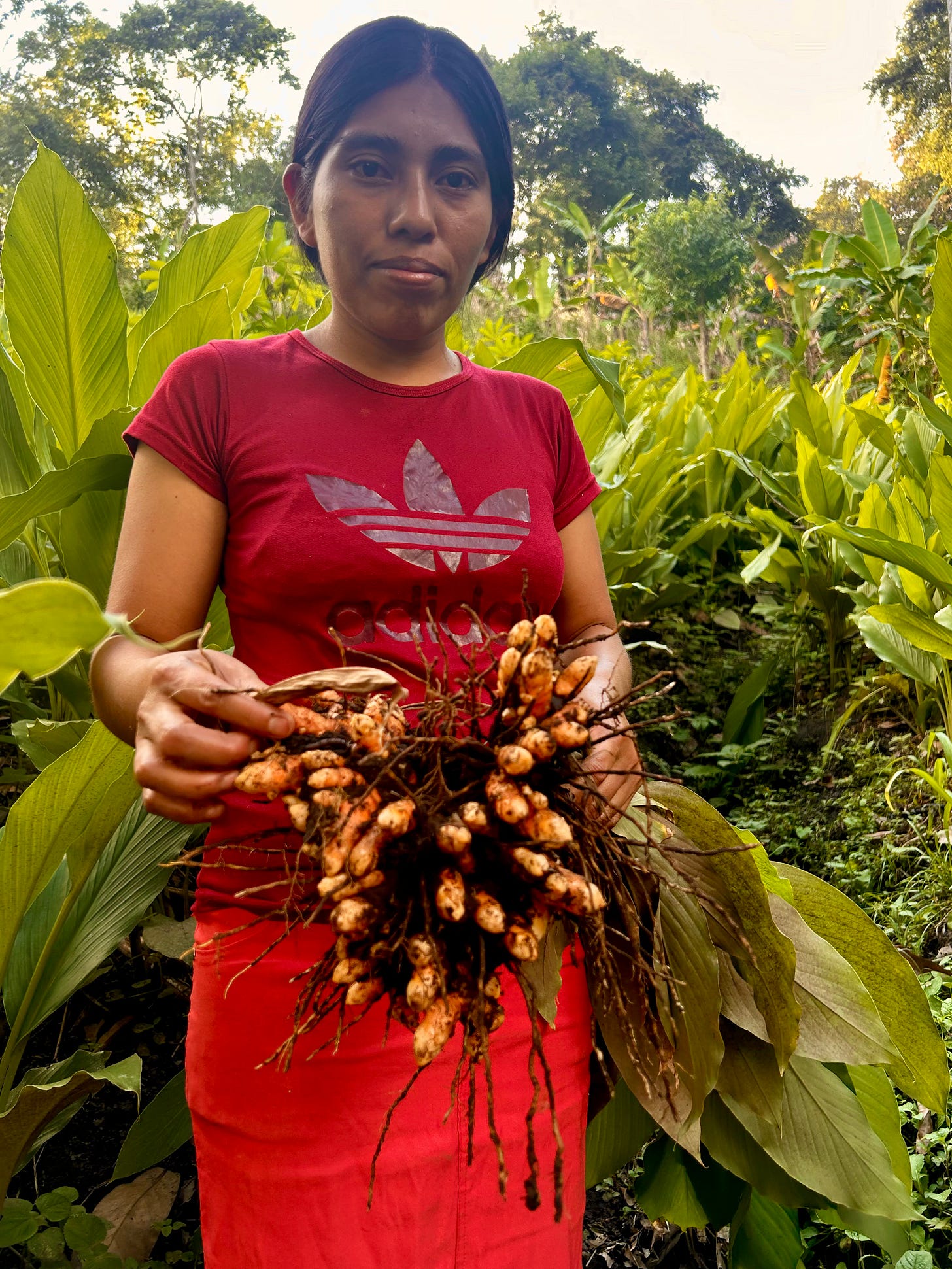
Others shared how fulfilled and happy and grateful they felt. That they felt true reciprocity in the experience and felt enriched on so many levels. Jefferson shared how deeply relieved he felt. The trust we had in him and the trust the farmers and Doselva staff had in each other had allowed them to try something different.
Raj noted the value of kindness as a choice. “We could enter in a way that was smooth,” he said, “and that was not accidental.” He said his core motivation in working with small tea pickers in northern India is to pursue systems change, bringing in the head and the heart. His heart is very clear. In his head it is more complicated. Their work exists in a world where forces are set against the success of smallholders. “There are really big tides we are swimming against,” he said. Today he was reminded of the scale of those tides. What gives him hope is doing what we did today: shrinking the gaps by bringing actors closer together.
Nate reminded us of Estania’s answer to our question about what they need most right now, “We need friends,” she had said.
Systems Mapping: Revealing Hidden Dynamics
3D mapping exercise
On the final afternoon, we did 3-D mapping, a Presencing Institute method we have done before in SHI Learning Labs. This time we worked in small groups to map the stakeholders and complex forces in the herbal products industry.
Identifying systemic challenges
Our group began by identifying certain forces, power and money that impacted the system. We put different items for the different stakeholders. As we went on, we identified deeper things impacting the whole: spirit was on the outside, knocked over. The beautiful bird of paradise flower blocked consumers from seeing the impacts of their choices, imagining that when they bought herbal products they were contributing to that beauty. Global poverty and climate change hung over the single serving of sugar pierced through with a toothpick: capitalism and the history of colonialism, all bearing down on the garlic head representing primary processors around the world. Money was on top of the power block, far from global poverty and climate change.
We used archetype cards to represent each of us, which we placed in the map. Finn from South Africa commented on how each of our cards were slightly apart, that we didn’t feel so connected. And so, we realized that the map was missing: fear, the fear that keeps us from connecting more deeply.
We then stood to the east, the west, the north and the south and answered questions for each direction: What hard truths is this map revealing? What is dying? What is emerging? What is at risk if nothing changes and what is at risk if everything changes? If this map could speak, what would it say to us?
Reimagining supply chain relationships
Then we moved the objects according to what emerged, noticing the first two or three actions that we took as acupuncture points or leverage points of change.
The first thing we did was remove fear. We just took it off the map, though in reality that move likely isn’t that easy.
We then moved the bird of paradise flower shielding consumers from seeing the truth of this industry and the impacts of their actions on global poverty and climate change.
We stood spirit up and placed it on top of the power block at the center of the map.
We redistributed financial power across the supply chain—allocating resources to wild harvesters, farming communities, and primary processors—to ensure that wealth wasn’t concentrated at the top.
We moved farmers and wild harvesters closer to the center and closer to quality.
Consumers became empowered by seeing the impact of their actions.
We removed the ear plugs preventing everyone from hearing what they didn’t want to hear.
The two other groups identified similar steps:
Centering Gaia and people, plants, and place at the center, not power and government. Creating thick feedback loops from consumers to the source.
Chain is less linear.
Regulatory framework is more compassionate.
Status quo went away – allowing us to imagine other ways of doing business.
Collective Reflection: Emerging Possibilities
The Forest Floor
On the final morning, before we had done the mapping exercise, Guido guided us on a journey to build the forest floor together (We had planned to go to the actual Gaia Farm, but heavy rains from a hurricane prevented that). He included everyone: the trees we had encountered on our travels through Nicaragua, the plants, the children at the farms, the farmers we met, the wind coming down from the volcano, the flame in each of our hearts. Jefferson and I passed around ginger and turmeric tea, made with rhizomes from Nicaraguan farms, and we each sat with the experience and the plants.
Visions for transformative change in the herbal industry
In the circle after the forest and the journey with ginger, some of what was shared:
Nate said that SHI offers him built in friends and built in responsibilities. He thought about all that needs to be silenced so we can do business. All the is erased so we can trade tons of material. SHI brings the voices of the people who have been there all along but have been silenced. Sheds the veils to bring in that accountability because we can’t pretend to not hear it anymore.
Sharing the lives and hard work so that buying and selling herbs isn’t just a transaction on a piece of paper.
Remember to ask: Why are we doing things this way? Is it the right way just because it is set up that way? Does it bring love? Or does it bring pain?
Finn grew up in the forest and it felt like a cycle and a cycle. He went to school and into the industry of conservation. And then everything became a line. He began searching for a way for that line to become a circle again, to fall in love, he said. But all he found were gardens using glyphosate to facilitate an experience of awe. He was battling a system that was not willing to change.
So he left that and came across local herbs, the intricate connection with the plants. And he believed through story that people would start grounding themselves in the landscape and the cycle would be found. But he found an industry that has its own poisons. This time he wants to lean into it, though and to not run away. Before the Learning Journey, it felt so difficult to look at the lies. But this circle and SHI gives him the confidence to look at the poisons with our eyes open, to explore together how we can produce this cycle again. He can lean into it, and he can lean on others in this circle as well.
Others in the circle continued to share these themes. Zacharia Levine mentioned the first step of healing is to not dust over the lies. Matt Richards mentioned that SHI embodies a different way of being in a system, one that is aligned with the flow of nature. How can we help enable and not block that flow?
Briana Buckles continued this thread by talking about the need to be closer together. She said the only reason bigger companies aren’t buying from companies like Doselva is because it is hard. How can we bring those connections closer so that it is easier to do the right thing?
John Munsell mentioned the rift between people and nature, that we can’t make changes on the outside without making them inside. He asked, “How can we all become better occupants on this planet?”
Julia Weaver wondered how to amplify the ripples that the shift that heart centered decision making can have.
Guido said that ginger told him, “You don’t need to walk alone. I get lost because there is so much fear and separation.” Your customers want to feel that love. SHI offers another way of knowing through process and embodied learning that is really useful and can enliven this web.
I mentioned my sense of how the industry needs this, this aliveness, this connection. It needs roots in the earth, people’s hands in the soil. It needs us bearing witness to these lives and it needs us each connecting to our own individual fire to bring in our own creativity and passion.
Erin Smith commented on what having nature speak does for our perceptions, as a being that has a voice. “It feels like a remembering,” she said.
And a final comment, I’m not sure who said it. “Who is benefiting from the way things are set up? SHI can’t fall back on inaction. Love is our responsibility.”
I found myself gathered with others on the forest floor. Though I couldn’t have described it, I realized this had been my vision. For all of us to be present on the forest floor, present to what arises, listening to that arising and tending it, creating a structure that contains the flow, so that our work is aligned with all that is living. I didn’t do anything. I followed my own longing for depth and connection and that led me to others who felt that longing as well.
I didn’t know if it would work. But now that I see it does, what does that mean? It means not institutionalize it, but to trust it. To trust how we got here. To trust that process as a way to continue to deepen and expand the circle.
As Guido said after we returned, “Let’s keep it going.”



